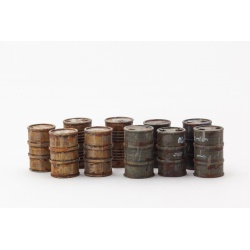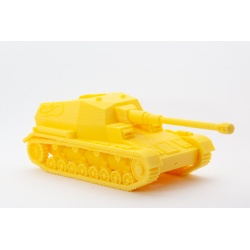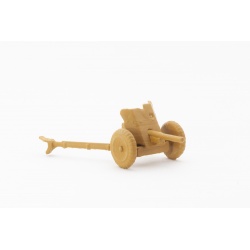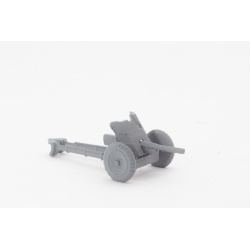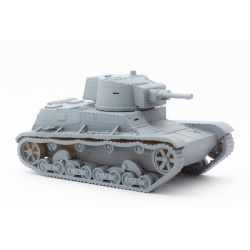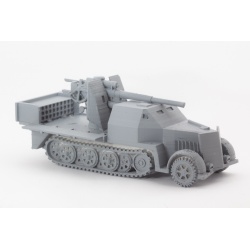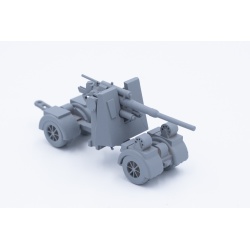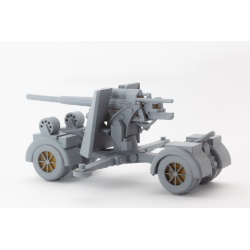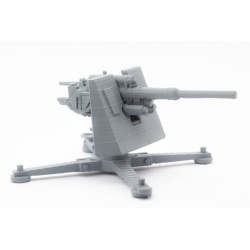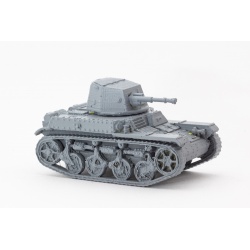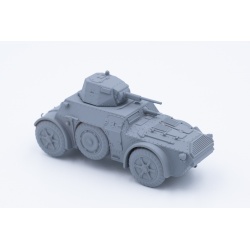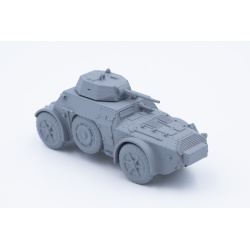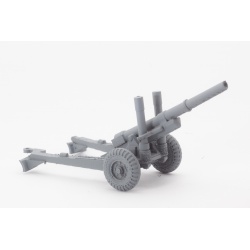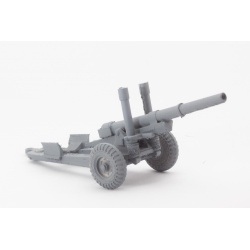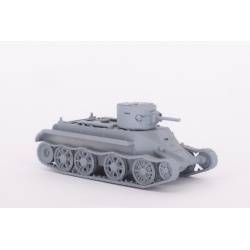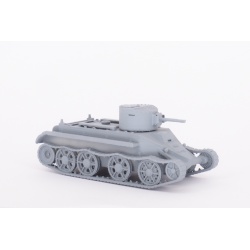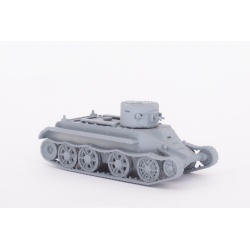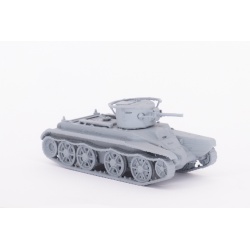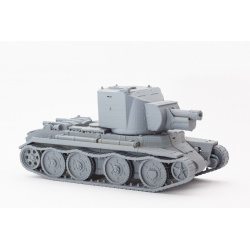TigerAce1945
![]()
10 Oil Barrels
A set of 10 oil drums. Can be used as terrain or objective markers.
Each barrel measures approximately 12mm diameter by 19mm tall and are suitable as 1/56 or 28mm scale.
Each barrel measures approximately 12mm diameter by 19mm tall and are suitable as 1/56 or 28mm scale.
supplied unpainted
10.5 cm K gepanzerte Selbstfahrlafette
Model comes in three parts; Hull and Tracks.
The Dicker Max was a German prototype self-propelled gun designed as a bunker buster for the Maginot Line in France.
It was built on a Pz.Kpfw IV E chassis and featured a 20.cm schwere Kanone 18 gun.
Only 2 models were built. They saw action in Russia with the Panzerjager Abteilung 521. One was destroyed by fire after flames spread to the ammunition and it exploded. The other fought into 1942.
The Dicker Max was a German prototype self-propelled gun designed as a bunker buster for the Maginot Line in France.
It was built on a Pz.Kpfw IV E chassis and featured a 20.cm schwere Kanone 18 gun.
Only 2 models were built. They saw action in Russia with the Panzerjager Abteilung 521. One was destroyed by fire after flames spread to the ammunition and it exploded. The other fought into 1942.
Dicker Max
3.7cm Pak 36
Model comes as one part.
The Pak 36 is a 3.7cm anti-tank gun.
It was used between 1936 and 1945. Germany had just over 9,000 Pak 36s at the start of the war and made another 5,339 during the war.
It had a crew of 5; commander, gunner, loader and 2 ammunition carriers.
The Pak 36 is a 3.7cm anti-tank gun.
It was used between 1936 and 1945. Germany had just over 9,000 Pak 36s at the start of the war and made another 5,339 during the war.
It had a crew of 5; commander, gunner, loader and 2 ammunition carriers.
Panzerabwehrkanone 36
3.7cm Pak 36 (limbered)
Model comes as one part.
The Pak 36 is a 3.7cm anti-tank gun.
It was used between 1936 and 1945. Germany had just over 9,000 Pak 36s at the start of the war and made another 5,339 during the war.
It had a crew of 5; commander, gunner, loader and 2 ammunition carriers.
This is the limbered version for towing.
The Pak 36 is a 3.7cm anti-tank gun.
It was used between 1936 and 1945. Germany had just over 9,000 Pak 36s at the start of the war and made another 5,339 during the war.
It had a crew of 5; commander, gunner, loader and 2 ammunition carriers.
This is the limbered version for towing.
Panzerabwehrkanone 36
6 Oil Barrels
A set of 6 oil drums. Can be used as terrain or objective markers.
Each barrel measures approximately 12mm diameter by 19mm tall and are suitable as 1/56 or 28mm scale.
Each barrel measures approximately 12mm diameter by 19mm tall and are suitable as 1/56 or 28mm scale.
supplied unpainted
7TP jw Light Tank
This model comes in four parts; hull, turret & tracks.
The 7TP was a development of the British Vickers 6 Ton tank and was used during the invasion of Poland in 1939. Some 150 7TPs were built.
There were twin and single turret versions of the 7TP, the dw “dwuwieżowy” was the dual turret version while the single turret was designated jw “jednowieżowy”. It weighed 9.9 tonnes and had a crew of three; driver, commander and gunner.
The 7TP was armed with a 37 mm Bofors wz. 37 gun and a 7.92mm Ckm wz.30 machine gun.
Most of the 7TPs were attached to the 1st and 2nd Light Tank Battalions.
The 7TP was a development of the British Vickers 6 Ton tank and was used during the invasion of Poland in 1939. Some 150 7TPs were built.
There were twin and single turret versions of the 7TP, the dw “dwuwieżowy” was the dual turret version while the single turret was designated jw “jednowieżowy”. It weighed 9.9 tonnes and had a crew of three; driver, commander and gunner.
The 7TP was armed with a 37 mm Bofors wz. 37 gun and a 7.92mm Ckm wz.30 machine gun.
Most of the 7TPs were attached to the 1st and 2nd Light Tank Battalions.
Siedmiotonowy Polski - 7
8.8 cm Flak 18 (Sfl.) auf Zugkraftwagen
Model comes as two parts: Truck and Gun.
Ar the start of the war 10 Sd.Kfz 8 & 9s were altered to carry the 8.8cm Flak. The cab replaced with armour. It was also known as the Bunkerflak.
The vehicles saw action in the invasion of Poland and France an Operation Barbarossa. It weighed 20 tons.
Ar the start of the war 10 Sd.Kfz 8 & 9s were altered to carry the 8.8cm Flak. The cab replaced with armour. It was also known as the Bunkerflak.
The vehicles saw action in the invasion of Poland and France an Operation Barbarossa. It weighed 20 tons.
Flakbus
8.8cm Flak 36 (carriage stowed)
Model comes in two parts, gun and carriage (resin)
The 88mm Flak 36 is one of the most widely recognised weapons of World War II and was in service between 1936 and 1945. Over 21,000 units were produced.
It could be used as both anti-aircraft and anti-tank artillery and could fire 18 to 20 rounds per minute. It had a range of almost 10km or a ceiling of 35,000 ft.
The gun had a crew of 10.
This model comes on wheeled gun carriage. The gun can be rotated or removed from the carriage. The side legs of the carriage are in the stowed position.
Note: (Model is only available as a resin print)
The 88mm Flak 36 is one of the most widely recognised weapons of World War II and was in service between 1936 and 1945. Over 21,000 units were produced.
It could be used as both anti-aircraft and anti-tank artillery and could fire 18 to 20 rounds per minute. It had a range of almost 10km or a ceiling of 35,000 ft.
The gun had a crew of 10.
This model comes on wheeled gun carriage. The gun can be rotated or removed from the carriage. The side legs of the carriage are in the stowed position.
Note: (Model is only available as a resin print)
German Artillery
8.8cm Flak 36 (carriage)
Model comes in two parts, gun and emplacement.
The 88mm Flak 36 is one of the most widely recognised weapons of World War II and was in service between 1936 and 1945. Over 21,000 units were produced.
It could be used as both anti-aircraft and anti-tank artillery and could fire 18 to 20 rounds per minute. It had a range of almost 10km or a ceiling of 35,000 ft.
The gun had a crew of 10.
This model comes on wheeled gun carriage. The gun can be rotated or removed from the carriage.
The 88mm Flak 36 is one of the most widely recognised weapons of World War II and was in service between 1936 and 1945. Over 21,000 units were produced.
It could be used as both anti-aircraft and anti-tank artillery and could fire 18 to 20 rounds per minute. It had a range of almost 10km or a ceiling of 35,000 ft.
The gun had a crew of 10.
This model comes on wheeled gun carriage. The gun can be rotated or removed from the carriage.
on gun carriage
8.8cm Flak 36 (emplacement)
Model comes in two parts, gun and emplacement.
The 88mm Flak 36 is one of the most widely recognised weapons of World War II and was in service between 1936 and 1945. Over 21,000 units were produced.
It could be used as both anti-aircraft and anti-tank artillery and could fire 18 to 20 rounds per minute. It had a range of almost 10km or a ceiling of 35,000 ft.
The gun had a crew of 10.
This model comes on the static emplacement. The gun can be rotated or removed from the emplacement.
The 88mm Flak 36 is one of the most widely recognised weapons of World War II and was in service between 1936 and 1945. Over 21,000 units were produced.
It could be used as both anti-aircraft and anti-tank artillery and could fire 18 to 20 rounds per minute. It had a range of almost 10km or a ceiling of 35,000 ft.
The gun had a crew of 10.
This model comes on the static emplacement. The gun can be rotated or removed from the emplacement.
on emplacement
AMR-35
Model comes in two parts; Hull & Turret.
The AMR-35 was an infantry support tank produced between 1936 and 1939. There were several variants and a total of 167 plus all the variants were built.
It weighed 6.5 tonnes and carried a 7.5mm Reibel machine gun or a 13.2 Hotchkiss machine gun.
The AMR-35 was an infantry support tank produced between 1936 and 1939. There were several variants and a total of 167 plus all the variants were built.
It weighed 6.5 tonnes and carried a 7.5mm Reibel machine gun or a 13.2 Hotchkiss machine gun.
Automitrailleuse de Reconnaissance Renault Modèle 35 Type ZT
Autoblinda 41
Model comes in two parts; body & turret (resin).
The Autoblinda was an Italian armoured car manufactured by Fiat-Ansaldo between 1941 & 1943. It came in three versions, 40, 41 & 43, named after the year of production.
Most versions were armed with a 35mm Breda 20mm autocannon and an 8mm coaxial machine gun.
Some 550 of all versions were built and they were used by Italy & Germany.
Note: (Model is only available as a resin print)
The Autoblinda was an Italian armoured car manufactured by Fiat-Ansaldo between 1941 & 1943. It came in three versions, 40, 41 & 43, named after the year of production.
Most versions were armed with a 35mm Breda 20mm autocannon and an 8mm coaxial machine gun.
Some 550 of all versions were built and they were used by Italy & Germany.
Note: (Model is only available as a resin print)
Italian Armoured Car
Autoblinda 43 (v2)
Model comes in two parts; body & turret (resin).
The Autoblinda was an Italian armoured car manufactured by Fiat-Ansaldo between 1941 & 1943. It came in three versions, 40, 41 & 43, named after the year of production.
Most versions were armed with a 35mm Breda 20mm autocannon and an 8mm coaxial machine gun.
Some 550 of all versions were built and they were used by Italy & Germany.
Note: (Model is only available as a resin print)
The Autoblinda was an Italian armoured car manufactured by Fiat-Ansaldo between 1941 & 1943. It came in three versions, 40, 41 & 43, named after the year of production.
Most versions were armed with a 35mm Breda 20mm autocannon and an 8mm coaxial machine gun.
Some 550 of all versions were built and they were used by Italy & Germany.
Note: (Model is only available as a resin print)
Italian Armoured Car
BL 5.5 inch Medium Gun
Model comes as 4 parts; base, gun and wheels.
5,000 5.5 inch guns were made which saw service with the British Army as well as Canadian, Australian, South African, Polish and Indian regiments. It entered service in 1941 and remained in use up until 1980, seeing action in WWII, Korean War and Iran-Iraq war.
It weighed 6 tonnes and had a crew of 8.
5,000 5.5 inch guns were made which saw service with the British Army as well as Canadian, Australian, South African, Polish and Indian regiments. It entered service in 1941 and remained in use up until 1980, seeing action in WWII, Korean War and Iran-Iraq war.
It weighed 6 tonnes and had a crew of 8.
British Artillery
BL 5.5 inch Medium Gun (limbered)
Model comes as 4 parts; base, gun and wheels.
5,000 5.5 inch guns were made which saw service with the British Army as well as Canadian, Australian, South African, Polish and Indian regiments. It entered service in 1941 and remained in use up until 1980, seeing action in WWII, Korean War and Iran-Iraq war.
It weighed 6 tonnes and had a crew of 8.
This is the limbered version for towing.
5,000 5.5 inch guns were made which saw service with the British Army as well as Canadian, Australian, South African, Polish and Indian regiments. It entered service in 1941 and remained in use up until 1980, seeing action in WWII, Korean War and Iran-Iraq war.
It weighed 6 tonnes and had a crew of 8.
This is the limbered version for towing.
British Artillery
BT-2 (version 1)
Model comes as 4 parts; hull, turret & tracks.
The BT series of Russian tanks were light cavalry tanks which were in service between 1932 and 1945. There were several models and many variants.
The BT-2 weighed 11 tonnes and had a crew of three. 650 were made.
three turret versions were produced: with single 37mm gun; 37mm gun and one DT machine gun; twin DP machine guns mount and a single machine gun.
This is the early production hull with 37mm gun and DT machine gun.
The BT series of Russian tanks were light cavalry tanks which were in service between 1932 and 1945. There were several models and many variants.
The BT-2 weighed 11 tonnes and had a crew of three. 650 were made.
three turret versions were produced: with single 37mm gun; 37mm gun and one DT machine gun; twin DP machine guns mount and a single machine gun.
This is the early production hull with 37mm gun and DT machine gun.
Russian Tank
BT-2 (version 2)
Model comes as 4 parts; hull, turret & tracks.
The BT series of Russian tanks were light cavalry tanks which were in service between 1932 and 1945. There were several models and many variants.
The BT-2 weighed 11 tonnes and had a crew of three. 650 were made.
three turret versions were produced: with single 37mm gun; 37mm gun and one DT machine gun; twin DP machine guns mount and a single machine gun.
This is the early production hull with single 37mm gun.
The BT series of Russian tanks were light cavalry tanks which were in service between 1932 and 1945. There were several models and many variants.
The BT-2 weighed 11 tonnes and had a crew of three. 650 were made.
three turret versions were produced: with single 37mm gun; 37mm gun and one DT machine gun; twin DP machine guns mount and a single machine gun.
This is the early production hull with single 37mm gun.
Russian Tank
BT-2 (version 3)
Model comes as 4 parts; hull, turret & tracks.
The BT series of Russian tanks were light cavalry tanks which were in service between 1932 and 1945. There were several models and many variants.
The BT-2 weighed 11 tonnes and had a crew of three. 650 were made.
three turret versions were produced: with single 37mm gun; 37mm gun and one DT machine gun; twin DP machine guns mount and a single machine gun.
This is the early production hull with twin and single machine guns.
The BT series of Russian tanks were light cavalry tanks which were in service between 1932 and 1945. There were several models and many variants.
The BT-2 weighed 11 tonnes and had a crew of three. 650 were made.
three turret versions were produced: with single 37mm gun; 37mm gun and one DT machine gun; twin DP machine guns mount and a single machine gun.
This is the early production hull with twin and single machine guns.
Russian Tank
BT-2 Command (mid)
Model comes as 4 parts; hull, turret & tracks.
The BT series of Russian tanks were light cavalry tanks which were in service between 1932 and 1945. There were several models and many variants.
The BT-2 weighed 11 tonnes and had a crew of three. 650 were made.
three turret versions were produced: with single 37mm gun; 37mm gun and one DT machine gun; twin DP machine guns mount and a single machine gun.
This is the command version with the radio turret and 37mm gun on a mid production hull.
The BT series of Russian tanks were light cavalry tanks which were in service between 1932 and 1945. There were several models and many variants.
The BT-2 weighed 11 tonnes and had a crew of three. 650 were made.
three turret versions were produced: with single 37mm gun; 37mm gun and one DT machine gun; twin DP machine guns mount and a single machine gun.
This is the command version with the radio turret and 37mm gun on a mid production hull.
Russian Tank
BT-42
Model comes in four parts; Hull, Turret & Tracks.
The BT series of Russian tanks were light cavalry tanks which were in service between 1932 and 1945. There were several models and many variants.
5,556 BT-7s of all varieties were built.
The BT-42 was a captured vehicle used by the Finnish Army. The turret was replaced with a QF 4.5 pound howitzer. The machine gun was removed to accommodate the gun.
18 models were used by the Finns.
The BT series of Russian tanks were light cavalry tanks which were in service between 1932 and 1945. There were several models and many variants.
5,556 BT-7s of all varieties were built.
The BT-42 was a captured vehicle used by the Finnish Army. The turret was replaced with a QF 4.5 pound howitzer. The machine gun was removed to accommodate the gun.
18 models were used by the Finns.
Bystrokhodny tank


